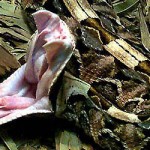By James P Watson
There are 2 “Mantras” Here in the Zoo – Hormesis and Nrf2 inducible Isoforms
Preface – By Vince Giuliano
I want to introduce and welcome James P Watson as a senior researcher and writer for this blog. James, a surgeon and stem cell researcher, has been responsible for contributing very astute comments in this blog James (Jim) and I have been in intensive interaction by e-mail and phone over the past few of weeks on a number of interesting topics relating to longevity science, including epigenetics, stem cell senescence, hormesis and the roles of Nrf2. I have been learning a lot in the course of this dialog and have come to deeply respect James depth in molecular biology as well as his breadth of his knowledge relative to the multiple scientific disciplines bearing on aging. I am honored that Dr. Watson has decided to join me as a researcher and writer for this blog.
This blog entry is a natural extension to the blog entries on hormesis and those on Nrf2 expression(ref)(ref)(ref)(ref) (ref). It is based on an e-mail sent me by Jim and our phone interactions. I have edited it a bit and added a few remarks for context. And I added the pictures.
Introduction
I have discovered a zoo in our cells! The “animals” are gases (CO, NO, H2S) and non- gases (HCN, O2-, H2O2, etc.), reactive species which are signaling molecules that act as 2nd messengers at hormetic doses. (“Second messengers are molecules that relay signals from receptors on the cell surface to target molecules inside the cell, in the cytoplasm or nucleus. They relay the signals of hormones like epinephrine (adrenaline), growth factors, and others, and cause some kind of change in the activity of the cell. They greatly amplify the strength of the signal.[1][2] Secondary messengers are a component of signal transduction cascades(ref).”) The zoo animals are definitely wild and some like carbon monoxide and hydrogen cyanide have very nasty reputations. Although they are deadly poisons, they are NOT toxins at hormetic doses! They are ACTIVELY produced and destroyed by enzymes in our bodies. Nrf2 controls the production of the enzymes that create and destroy these 2nd messengers, at least in most known cases. The regulation of these 2nd messengers is very tightly controlled by both synthesis and degradation. I suspect that these zoo animals most have half-lives of less than a second
- This is a small gaseous molecule enzymatically produced physiologically in minute quantities.
- At small concentrations it has major beneficial physiologic effects such as vasodilatation – ie. controlling blood flow.
- At higher concentrations, it has major detrimental effects, such as death! “It is the proximate cause of septic shock and may play a role in many diseases with an autoimmune etiology(ref)”
- NOS is being intensively studied as a signaling molecule and plays key roles in neuroinflammation and neurogenesis(ref)
- NOS is produced by nitric oxide synthethases (NOS) – “(NOSs) are a family of enzymes that catalyze the production of nitric oxide (NO) from L-arginine(ref).”
- Isoforms of NOS (forms of the protein) are regulated differently:
1. Nrf2 inducible isoform – NOS-2 – regulated by cellular stress
2. non-inducible isoform – eNOS – controlled by endothelial cell stress, blood flow turbulence, etc.
- Transcription factor controlling NOS-2: Nrf2
- how to non-invasively measure NO: expired air (i.e. in your breath!): machine: multichannel gas analyzer: Logan 2500, Logan Research Limited, Kent, UK. reproducible? – yes. sensitivity – 0.1%. time taken to measure this – 6-13 minutes
The wild animal is NO and the zoo keeper keeping it under control is NOS-2, via a NRF2 mechanisms.
- This is a small gaseous molecule enzymatically produced for signaling purposes in physiologically minute quantities
- It has major beneficial physiologic effects such as bronchodilation.
- At higher concentrations, it has major detrimental effects, such as competitive binding with oxygen on hemoglobin, which results in death!
- CO is produced by heme oxygenases (HO) – which again exist in different isoforms which are regulated differently.
1. NRF2 Inducible isoform – HO-1 – regulated by cellular stress
2. non-inducible isoform – HO – I don’t know what triggers this form
- Transcription factor controlling HO-1: NRF2
- how to non-invasively measure CO: expired air (i.e. in your breath!): machine: multichannel gas analyzer: Logan 2500, Logan Research Limited, Kent, UK. reproducible? – yes. Time taken to measure this – 6-13 min
The wild animal is CO and the zoo keeper keeping it under control is HO-1, via NRF2 mechanisms
Reference: Ryter SW, Otterbein LE, Morse D, Choi AM Heme oxygenase/carbon monoxide signaling pathways: regulation and functional significance Mol Cell Biochem. 2002 May-Jun;234-235(1-2):249-63.
See also Rochette L, Cottin Y, Zeller M, Vergely C. Carbon monoxide: Mechanisms of action and potential clinical implications. Pharmacol Ther. 2012 Sep 29. pii: S0163-7258(12)00209-4. doi: 10.1016/j.pharmthera.2012.09.007. [Epub ahead of print]
- H2S is again a small gaseous molecule, enzymatically produced in physiologic minute quantities
- It has major beneficial physiologic effects such as vasodilation – i.e. controlling blood vessel caliber and flow and involved in inflammation and in the regulation of cardiac response to ischemia and reperfusion injury.
- The nice thing about H2S is that it does not have the capacity to form a toxic metabolite (i.e. it is different in this regard from CO and NO), even though it smells very bad.
- H2S is produced by cystathionine γ-lyase (CSE) and cystathionine β-synthase (CBS) (ref)(ref), and probably by other naturally occurring enzymes.
1. Nrf2 Inducible isoform: CSE
2. non-inducible isoform –
- Transcription factor controlling CSE: Nrf2
- How to non-invasively measure H2S: no one has described this yet – we could win the Nobel prize for this!
The wild animal is H2S and the zoo keeper keeping it under control is CSE, via NRF2 mechanisms
Reference: Ling L, Rose P, Moore P, Hydrogen Sulfide and Cell Signaling, Annual Review of Pharmacology and Toxicology, Vol 51, pp 169-187, February, 2011
- HCN is a small molecule , that is enzymatically produced in physiologic minute quantities.
- HCN has major beneficial effects. (I am not sure what they all are yet).
- HCN signaling appears to mainly have been studied in plants. We know that HCN plays a signaling role in the germination of and development apple seedlings(ref)(ref)
- I also don’t know if HCN is under the control of Nrf2.
- What I do know is that at higher concentrations, HCN has major detrimental effects such as death!
- O2 is a small molecule (NOT a gas), that is enzymatically produced in physiologic minute quantities.
- O2 tat has major beneficial physiologic effects as a growth signal via the ras-NAD(P)H oxidase-MAPK signaling pathway,
– peroxisome proliferator-activator-activated receptor gamma (PPAR-gamma) pathway (involved with PGC-1alpha), etc.
- At higher concentrations, superoxide has major detrimental effects, such as death!
- Production: There are several inducible systems and several non-inducible systems
1. NRF2 Inducible O2- systems: NAD(P)H oxidase
2. Non-inducible O2- systems: mitochondria
- Scavengers:SOD1 (cytoplasm), SOD2 (mitochondria), SOD3 (plasma, extracellular space)
- Transcription factor controlling SODs: Nrf2
- How to non-invasively measure O2? No one has described this yet! We could win our 2nd Nobel prize for this
The wild animal is O2- and here the zoo keeper controls both the production of the wild animal (NADPH oxidase) and the destruction of the wild animal (SOD), via Nrf2
Reference: Buetler T, Krauskopf A, Ruegg U, Role of Superoxide as a Signaling Molecule, Physiology,Vol 19(3), pp 120-123, June 1, 2004
- H202 is a small molecule (NOT a gas), that is enzymatically produced in physiologic minute quantities.
- H202 has major beneficial physiologic effects as a cell signaling molecule.
- It does this via interaction with redox sensitive proteins with a cystein-sulfhydryl group on them with a low pKa at their active sites.
- Here is a list of them (i.e. redox sensitive cell signaling molecules:
Cysteine Residue proteins:
– Thioredoxin
– Disulfide isomerase
– Cysteine proteases – Ex: caspaces
– peroxiredoxin –
– serine/threonine kinases – cAMP-dependent kinase, S6Kinase, cGMP-dependent kinase, etc.
- What molecules trigger H2O2 as a signaling molecule? PDGF
- At high levels, H2O2 can have detrimental effects such as death!
- Scavenger for H2O2:catalase, GST, etc.
- Transcription factor controlling scavenger system: Nrf2
- How to non-invasively measure H2O2? No one has described this. We could win our 3rd Nobel prize!
- In this case I don’t know if the zookeeper controls the production of the wild animal
The wild animal is H2O2 and here the zookeeper Nrf2 controls the destruction of the wild animal (catalase).
Reference: Rhee SG, Redox signaling: hydrogen peroxide as intracellular messenger, Experimental and Molecular Medicine,
Vol 31(2), pp 53-59, June, 1999
Summary: All of these small molecules function as intracellular 2nd messengers in some aspect, but do not work via the classic lock-and-key, enzyme pocket interactions with proteins. They are way too “reactive” to communicate this way! They are wild animals! They attack! They don’t shake hands and sing Kumbaya!. The way they communicate as 2nd messengers is to react with cysteine sulfhydryl groups on their targets which affects the protein they interact with, via some conformational change in shape of the protein. And they don’t live very long at all.
It was once thought that in cells these zoo animals were by-products of metabolism. No more. They are messengers which can bend proteins out of shape.
There are probably many more “wild animals in the zoo. Here are the ones I have not studied: peroxynitrate (ONOO-), thiyl peroxyl radical (RSOO), ferry radical (FeO2++), and the hydroxyl radical (OH). These may all interact with cystein residues with pKa of < 7.0. I think we have quite a zoo here!
One implication of all this is that we must bury the FRTA (Free radical theory of aging) as soon as possible! Free radicals and stress are essential in the fabric of life (ref)(ref)(ref). Another is that we have to stop thinking of substances as good and bad. It all depends on the dose and context and the very worst stuff like ccarbon monoxide gas – well – it is made by us, used by us and we need it. Hormesis rules the day! (ref)(ref)(ref). And oh yes, we recall that the master zookeeper Nrf2 is regulated by Keap1, which is the zoo keaper. A final thought relative to taking conventional antioxidants which kill free radicals: Don’t shoot the 2nd messengers.








Dear James,
Love your article…I call the zoo – the “biological internet” and I believe that in due course we will find many similarites.
Few years back I have suggested that what the Chinese call chi/qi is a general concept for our zoo.
http://www.ncbi.nlm.nih.gov/pmc/articles/PMC1180462/
I have also suggested that operating the system smartly is a tool for healh, e.g. losing weight
http://nettingno.blogspot.co.il/2009/03/does-no-metabolism-play-role-in-effects.html
A question –
did you see the recent PNAS article?
http://www.ncbi.nlm.nih.gov/pubmed/23012472
It made me ponder if NO coming from citruline will behave differnetly than NO coming from nitrites?
Pingback: Multifactorial hormesis – the theory and practice of maintaining health and longevity | AGING SCIENCES – Anti-Aging Firewalls
Pingback: Mitochondria Part 2: Mitochondrial Responses to Stress: Mitochondrial Signaling: Survival and Death Pathways | AGING SCIENCES – Anti-Aging Firewalls